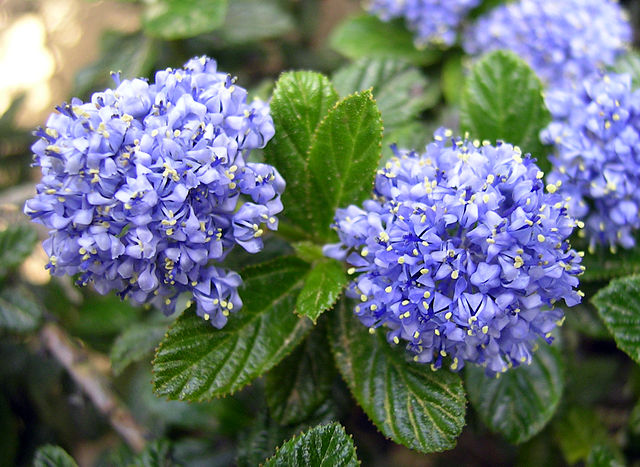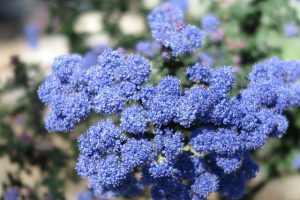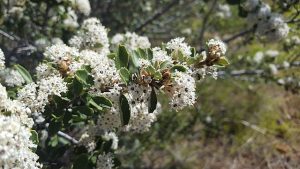Ceanothus, native to the Southern California, is a gorgeous shrub known for its intensely blue flowers. Commonly known as California lilac, this evergreen plant is an excellent choice for the chaparral inspired, drought tolerant landscape.
Ceanothus, which has many different varieties within the genus, can grow from 2 to 20 feet all, with a similar spread. Once it’s established (after around a year from planting time) it has very low water requirements.
Ceanothus is famous for its brilliant blue flowers
Landscape Planting – Ceanothus basics
Botanical Name: Ceanothus spp.
Common Name: California lilac, mountain lilac
Type: Evergreen, perennial, shrub
Native Range: Coastal ranges of California (particularly the southern half) and Baja California
Size: 2 – 20 feet tall, similar width, depending on the specific ceanothus species
Bloom Time: Spring to winter, depending on species
Bloom Description: Blue, pink, white
Sun: Full sun to partial shade
Growth Rate: Slow
Water: New plantings need regular, deep water while becoming established in the landscape (often around one year). Once established, deep soaking around once a month during hot, dry periods, otherwise they irrigation can be left off
Maintenance: These plants should only be pruned lightly, if necessary. Remove interior branches with no leaves after bloom to promote new growth.
Suggested Use: Specimen planning, border planting, informal hedges
Ceanothus blooms also come in white and pink
For landscape planting, California lilac usually grows best in full sun areas, but some species can handle partial shade. Our landscape designers at Creative Concepts Landscape will be happy to look over your property and determine areas that are optimal for these types of plants.
These plants are also deer resistant, making them a great choice in the foothills where deer damage is more common.
Our designers can take a look at your property and see if ceanothus’ needs can be met. We create a design plan for all of our consultations to determine what plants and needs match each individual property. Ceanothus makes an excellent addition to water-wise gardens. Their deep green leaves with bursts of deep blue flowers look at home in chaparral themed landscapes, they can be incorporated into many different design types. Again, Creative Concepts Landscape will help to determine the best location on your property, or create the conditions to promote a healthy, beautiful garden.
California lilac has low water requirements, perfect for the drought tolerant garden. In the first year after planting, while your California lilac is establishing itself in the landscape, they will need irrigation systems or regular hand watering. Creative Concepts Landscape has installed many irrigation systems (drip and sprinkler), and we would be happy to take a look at your property to come up with a design that could meet California lilac’s needs. Once these plants are established (usually around one year after planting) the irrigation can be reduced. They tend to like deep supplemental water once a month during hot, dry periods. If there is rain, the irrigation can be turned off completely in fall through winter.
These plants also prefer well-draining soils. Most of the natural soil in Southern California is somewhat sandy, well-draining soil.
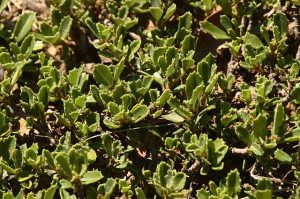
The leaves of a prostrate ceanothus. These species and varieties make for an excellent ground cover plant
Pruning & Maintenance
Ceanothus is low in maintenance needs. In many cases, providing supplemental water for these plants, while they are becoming established, is the highest maintenance requirement. Creative Concepts Landscape has been installing irrigation systems for over twenty years. We will be happy to schedule a consultation and come up with an irrigation system plan and install it. Creative Concepts landscape also repairs and refurbishes existing irrigation systems, so they are in optimal, efficient condition.
Outside of maintaining an irrigation system for Ceanothus while it is establishing, the plant should mostly be left alone. After the blooms have died, pruning shears can be used to remove some of the interior branches that no longer have leaves. Any pruning should be done sparingly and prudently. Ceanothus does not respond well to severe pruning, and they should be giving enough space in the landscape to grow to their natural form.
Creative Concepts Landscape has options for maintenance schedules. Many of our clients have us maintain their property weekly or two times a month, however we also offer periodic cleanups. These cleanups range from four times a year, twice a year, and sometimes once a year. We will be happy to talk with you and determine a maintenance/cleanup schedule that fits your property needs.
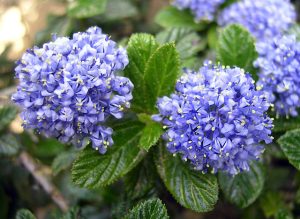
Ceanothus leaves and blooms in full beauty
Landscape Uses
For landscape planting, ceanothus grows well in a variety of locations and is useful as an eye-catching specimen plant or informal hedge (do not shear ceanothus into any forms other than its natural shape). Creative Concepts Landscape gets many requests for water-wise (drought tolerant) garden installations, of which ceanothus can be a beautiful addition. Our team of designers and technicians has decades of experience designing and installing gardens.
Ceanothus is known for its lovely branching structure and gorgeous blooms. It also attracts beneficial pollinators such as butterflies, bees, and hummingbirds.
Creative Concepts Landscape creates a landscape plan and design for your specific property characteristics along with your wants. Our highly experienced designers will be able to see what plant types and layout will complement your landscape’s existing features to come up with a planting design plan.
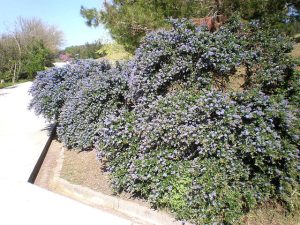
Some ceanothus species make for excellent informal hedges
Thank you for joining us again in this week’s horticultural adventures. Please come back next Wednesday for out next blog post, and as always, contact us for all your landscape needs!
By Daniel Williams
Client Liaison for Creative Concepts Landscape

